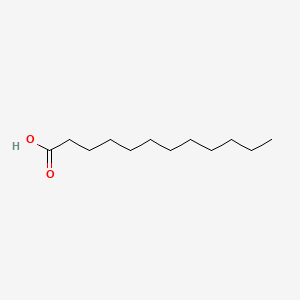lauric acid
lauric acid is a lipid of Fatty Acyls (FA) class. Lauric acid is associated with abnormalities such as Infection, Renal tubular disorder, Hypertensive disease, Obesity and Mycoses. The involved functions are known as Transcription, Genetic, Signal Transduction, Mutation, metaplastic cell transformation and Anabolism. Lauric acid often locates in Skin, Plasma membrane, Cytoplasmic matrix, Body tissue and Palmar surface. The associated genes with lauric acid are Gene Family, SLC33A1 gene, Homologous Gene, Open Reading Frames and P4HTM gene. The related lipids are Fatty Acids, Oleic Acids, Palmitates, Stearates and 9,11-linoleic acid.
Cross Reference
Introduction
To understand associated biological information of lauric acid, we collected biological information of abnormalities, associated pathways, cellular/molecular locations, biological functions, related genes/proteins, lipids and common seen animal/experimental models with organized paragraphs from literatures.
What diseases are associated with lauric acid?
lauric acid is suspected in Renal tubular disorder, Hypertensive disease, Infection, Renal vascular disorder, Obesity, Mycoses and other diseases in descending order of the highest number of associated sentences.
Related references are mostly published in these journals:
| Disease | Cross reference | Weighted score | Related literature |
|---|
Possible diseases from mapped MeSH terms on references
We collected disease MeSH terms mapped to the references associated with lauric acid
PubChem Associated disorders and diseases
What pathways are associated with lauric acid
There are no associated biomedical information in the current reference collection.
PubChem Biomolecular Interactions and Pathways
Link to PubChem Biomolecular Interactions and PathwaysWhat cellular locations are associated with lauric acid?
Visualization in cellular structure
Associated locations are in red color. Not associated locations are in black.
Related references are published most in these journals:
| Location | Cross reference | Weighted score | Related literatures |
|---|
What functions are associated with lauric acid?
Related references are published most in these journals:
| Function | Cross reference | Weighted score | Related literatures |
|---|
What lipids are associated with lauric acid?
Related references are published most in these journals:
| Lipid concept | Cross reference | Weighted score | Related literatures |
|---|
What genes are associated with lauric acid?
Related references are published most in these journals:
| Gene | Cross reference | Weighted score | Related literatures |
|---|
What common seen animal models are associated with lauric acid?
There are no associated biomedical information in the current reference collection.
NCBI Entrez Crosslinks
All references with lauric acid
Download all related citations| Authors | Title | Published | Journal | PubMed Link |
|---|---|---|---|---|
| Li L and Ma Y | Effect of fatty acids on the β-oxidation system and thioesterase of Lactococcus lactis subspecies lactis. | 2013 | J. Dairy Sci. | pmid:23462166 |
| Rico CM et al. | Effect of cerium oxide nanoparticles on the quality of rice ( Oryza sativa L.) grains. | 2013 | J. Agric. Food Chem. | pmid:24188281 |
| Roux M et al. | Dynamic lipid lateral segregation driven by lauryl cyclodextrin interactions at the membrane surface. | 2013 | Langmuir | pmid:23409976 |
| de Souza RL et al. | Protic ionic liquid as additive on lipase immobilization using silica sol-gel. | 2013 | Enzyme Microb. Technol. | pmid:23410924 |
| Inami Y et al. | Prevention of topical surfactant-induced itch-related responses by chlorogenic acid through the inhibition of increased histamine production in the epidermis. | 2013 | J. Pharmacol. Sci. | pmid:23449492 |
| Nafikov RA et al. | Sterol regulatory element binding transcription factor 1 (SREBF1) polymorphism and milk fatty acid composition. | 2013 | J. Dairy Sci. | pmid:23403193 |
| Giltrap AM et al. | Total synthesis of fellutamide B and deoxy-fellutamides B, C, and D. | 2013 | Mar Drugs | pmid:23880930 |
| Violante S et al. | Peroxisomes contribute to the acylcarnitine production when the carnitine shuttle is deficient. | 2013 | Biochim. Biophys. Acta | pmid:23850792 |
| Santos S et al. | Saturated fatty acids intake in relation to C-reactive protein, adiponectin, and leptin: a population-based study. | 2013 | Nutrition | pmid:23594583 |
| Inami Y et al. | Topical surfactant-induced pruritus: involvement of histamine released from epidermal keratinocytes. | 2013 | J. Pharmacol. Exp. Ther. | pmid:23220712 |
| Yamamoto H et al. | Development of vizantin, a safe immunostimulant, based on the structure-activity relationship of trehalose-6,6'-dicorynomycolate. | 2013 | J. Med. Chem. | pmid:23210481 |
| Coles L et al. | A model to predict the ATP equivalents of macronutrients absorbed from food. | 2013 | Food Funct | pmid:23233079 |
| Zhong N et al. | Solvent-free enzymatic synthesis of 1, 3-diacylglycerols by direct esterification of glycerol with saturated fatty acids. | 2013 | Lipids Health Dis | pmid:23656739 |
| Lu Y et al. | Enzymatic hydrolysis preparation of mono-O-lauroylsucrose via a mono-O-lauroylraffinose intermediate. | 2013 | J. Agric. Food Chem. | pmid:24050752 |
| van Kempen SE et al. | The effect of diesters and lauric acid on rheological properties of air/water interfaces stabilized by oligofructose lauric acid monoesters. | 2013 | J. Agric. Food Chem. | pmid:23863194 |
| Xu L et al. | Transfection efficiency of DNA enhanced by association with salt-free catanionic vesicles. | 2013 | Biomacromolecules | pmid:23865722 |
| Erwan E et al. | Lauroyl-L-aspartate decreased food intake and body temperature in neonatal chicks. | 2013 | Pharmacol. Biochem. Behav. | pmid:24141172 |
| Fernandes R et al. | Relationship between acute phase proteins and serum fatty acid composition in morbidly obese patients. | 2013 | Dis. Markers | pmid:24167354 |
| Tran NH et al. | An efficient light-driven P450 BM3 biocatalyst. | 2013 | J. Am. Chem. Soc. | pmid:24040992 |
| Shilling M et al. | Antimicrobial effects of virgin coconut oil and its medium-chain fatty acids on Clostridium difficile. | 2013 | J Med Food | pmid:24328700 |
